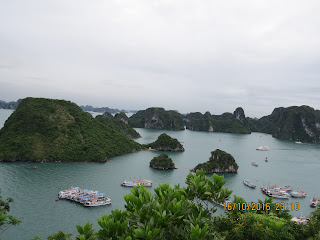We are heading to Tam Coc-Bich Dong today. It was about 100 kilometers from Hanoi City.Tam Coc which means 3 caves, is a zone of Vietnam that elapses between rice paddies, bathed by the Ngo Dong River punctuated by karstic rock formations and limestone caves.
The rock formations, caves, water and landscape have made Tam Coc to know popularly as La Halong Bay on land or between rice paddies Halong Bay. More accessible than her older sister, Halong Bay, Tam Coc which squanders spectacular landscapes and exoticism, do not get to seize the throne of the major tourist attraction of Vietnam for travelers.
The Bich Dong Pagoda
In 1773, Mr. Nguyen Nghiem (the father of the great writer Nguyen Du) visited this cave. After viewing the whole scenery of the mountains, waterways, fields, and sky covered in green mist, he gave the cave a very beautiful and romantic name, Bich Dong (which literally means “Green Pearl Grotto”). Bich Grotto has been said that the second most beautiful cave in Vietnam.
Bich Dong pagoda is on the short drive to the South of Tam Coc, it was built on the Truong Yen limestone mountains range, Hoa Lu district, Ninh Binh province. Bich Dong pagoda includes three palaces on three levels: Lower, Middle and Upper pagoda. The Low pagoda has five compartments built on the ground at the foot of mountain.
From the Low pagoda up to 120 steps is the impressive Middle pagoda with a half of it was carved into mountain including three compartments. Up to 40 steps is the High pagoda located on the highest point nearby the top of The Bich Dong mountain. From here you can have the wonderful perspective view of the Bich Dong pagoda.
Tam Coc
We took a two hours boat tour.
This is where the Kong movie, the Skull Island was filmed
We could not pass through this cave because the water level is too high due to rain the previous day.
Dinner
Day 6
This is the last day. There is no more visiting as all the planned visits were brought forward to yesterday and the day before. Just spent the morning walking around the hotel area. There was a fresh market somewhere near too.
The morning scene of Hanoi City.
The park in front of our hotel
The mysterious looking building is actually actually a circular French built water tower and it is called the Hang Dau Water Tower. It is located to the north of the Old Quarter and to the northeast of the Citadel. It is said to be the first to supply water for the city but it has not been utilized for the last few decades.
This we found at the fresh market. I guess they are selling almost the same things like us here.
The last lunch in Hanoi.
We were like hey it's cabbage again.





































































